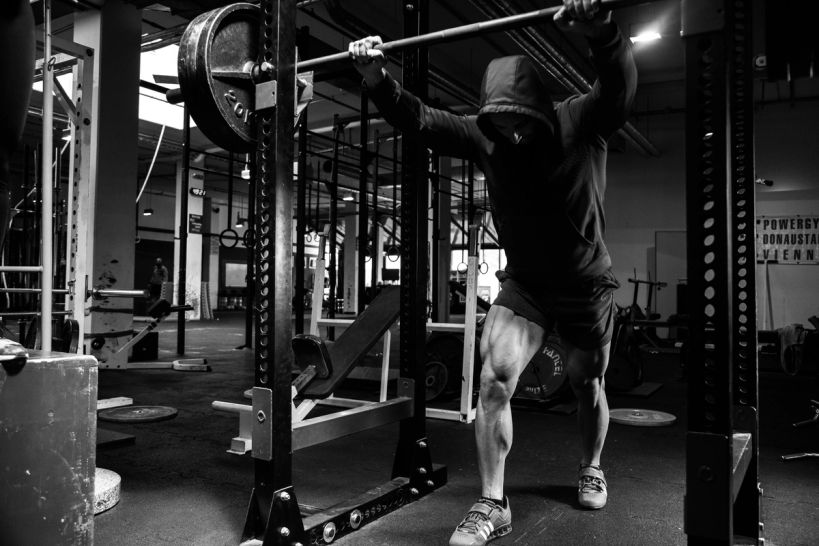7 Exercises You Should Avoid Over 40
Introduction
Welcome to the world of fitness, where age is just a number and exercise knows no boundaries. As we gracefully enter our 40s and beyond, it becomes even more crucial to prioritize physical activity for our overall well-being. Regular exercise not only helps us maintain a healthy weight, but it also boosts mood, improves cardiovascular health, enhances muscle strength, and increases flexibility.
The Importance of Exercise for Individuals Over 40
Once we hit our 40s, our bodies start undergoing certain changes that can impact our health and fitness levels. Muscle mass tends to decrease while body fat increases if we don't consciously work on maintaining muscle tone through exercise. Moreover, bone density decreases as we age, which makes regular weight-bearing exercises essential in preventing osteoporosis. Exercise also plays a vital role in supporting cardiovascular health. As we grow older, the risk of heart disease tends to increase due to factors such as sedentary lifestyle and metabolic changes. Engaging in aerobic activities like walking or cycling helps improve heart function and circulation. Mental well-being is equally significant as physical health when it comes to individuals over 40. Regular exercise has proven benefits for reducing stress levels, relieving anxiety and depression symptoms, improving sleep quality, and enhancing cognitive function.
The Need to be Cautious and Avoid Certain Exercises
While exercising is undoubtedly beneficial at any age, it's crucial for those over 40 to be mindful of their limitations and make informed choices about the type of exercises they engage in. Aging bodies tend to have reduced flexibility and joint mobility compared to their younger counterparts. In addition to being cautious about pushing oneself too hard during workouts or attempting unrealistic goals overnight (we're not trying out for the Olympics here), there are specific exercises that individuals over 40 should avoid altogether. These exercises may potentially put excessive strain on joints, increase the risk of injury, or exacerbate pre-existing medical conditions. It's essential to strike a balance between challenging ourselves and maintaining proper form while exercising. Remember, it's not about how much weight we lift or how fast we run; it's about longevity and sustainable progress. Adopting a holistic approach to fitness that prioritizes safety and individual limitations will ensure that exercise remains an enjoyable lifelong journey.
Understanding the Aging Body
Changes in muscle mass and strength with age
As we age, our bodies naturally undergo various changes, and one area that is significantly affected is our muscle mass and strength. In our younger years, our bodies have a higher percentage of lean muscle mass, which contributes to overall strength and agility. However, as we sail past the age of 40, the body's muscle tissue tends to decrease gradually. This process, known as sarcopenia, can result in a loss of around 3-5% of muscle mass per decade. Additionally, this decline in muscle mass can impact muscular strength and make it more challenging to perform certain exercises or physical activities. Although this natural aging process may seem discouraging, it's important to note that exercise can help mitigate these effects. Regular resistance training exercises using weights or resistance bands can stimulate the muscles and promote their growth and maintenance. Incorporating such workouts into your routine not only helps slow down the loss of muscle mass but also enhances overall strength and functional fitness.
Decreased flexibility and joint mobility
Alongside changes in muscle mass and strength, individuals over 40 often experience reduced flexibility and joint mobility. The soft tissues comprising tendons and ligaments tend to lose water content as we age, becoming less elastic. This leads to a decrease in joint range of motion and flexibility. Moreover, sedentary lifestyles or jobs that require long periods of sitting can contribute to tightness in muscles such as the hip flexors or hamstrings. This lack of flexibility increases the risk of strains or sprains during physical activity if not adequately addressed. Fortunately, there are several ways to counteract these limitations. Incorporating regular stretching exercises into your fitness routine is crucial for maintaining flexibility. Static stretches held for at least 30 seconds can help improve joint range of motion by gradually lengthening the muscles and connective tissue. Additionally, activities such as yoga or Pilates can enhance flexibility, core strength, and posture, all of which are vital for maintaining an active and healthy lifestyle. Understanding the aging body is key to tailoring an exercise routine that is safe and effective for individuals over 40. Recognizing the changes in muscle mass and strength allows us to implement resistance training exercises that target specific muscle groups while counteracting age-related decline. Moreover, acknowledging decreased flexibility and joint mobility highlights the importance of incorporating stretching exercises into our workouts to enhance range of motion and prevent injuries. By staying informed about these aspects of aging, we can create fitness regimens that prioritize our long-term well-being while keeping us active and vibrant as we journey through life.
Exercises to Avoid for Individuals Over 40
High-impact activities
When you hit the age of 40, it's important to be mindful of the impact your exercises have on your joints. High-impact activities like running on concrete or other hard surfaces can be particularly harsh on your knees and ankles. The repetitive pounding can lead to joint pain, inflammation, and even stress fractures. If you enjoy running, consider opting for softer surfaces like grass or using a treadmill with cushioning to absorb some of the impact.
Jumping exercises like box jumps or plyometrics
Jumping exercises are undeniably trendy and great for explosive power, but they may not be the best choice as you get older. These movements put significant strain on your joints, especially if performed with incorrect form or excessive intensity. The repetitive jumping motion can lead to wear and tear on ligaments and cartilage in your knees and hips. Instead of high-impact jumps, consider low-impact alternatives like step-ups or modified versions of jumping exercises that reduce the stress on your joints.
Heavy weightlifting without proper form and supervision
We all know that weightlifting is essential for maintaining muscle mass as we age, but it's crucial to approach it with caution after 40. Heavy lifts such as deadlifts or bench press can do wonders for building strength when performed correctly under proper supervision. However, using improper form or lifting excessively heavy weights without guidance increases the risk of injury significantly.
Deadlifts with excessive weight
The deadlift is a powerful compound exercise that targets multiple muscle groups simultaneously when executed correctly. However, attempting deadlifts with excessive weight beyond your capabilities is a recipe for disaster in midlife. Your lower back bears much of the load during this exercise, and improper technique or overly heavy weights can place unnecessary strain on your spinal discs, leading to back pain or even herniated discs. It's essential to start with lighter weights and focus on perfecting your form before gradually increasing the load.
Bench press without a spotter
Bench press is a classic upper body exercise that helps develop chest, shoulder, and tricep strength. Nevertheless, when you're over 40, it's wise to avoid bench pressing without a spotter. As you age, your joints become more vulnerable to injuries and accidents happen. Without someone there to assist you in case the weight becomes too much or you lose control during the movement, you risk straining muscles or worse—dropping the barbell on yourself.
Deep squats with heavy weights
Squats are an excellent compound exercise for developing lower body strength and maintaining functional mobility. However, deep squats with excessive weight can pose risks for older individuals. The increased stress placed on your knee joints when performing deep squats can exacerbate existing knee issues or potentially cause new ones if not executed properly. To protect your knees while still reaping the benefits of squats, consider using lighter weights and focusing on proper squatting technique rather than pushing for maximum depth. To ensure a safe and effective workout routine after 40, it's crucial to be mindful of exercises that may pose a higher risk of injury or joint stress. By avoiding high-impact activities like running on concrete or hard surfaces and opting for gentler alternatives such as grass or treadmills with cushioning, you can reduce the strain on your joints while still enjoying cardio workouts. Incorporating low-impact variations of jumping exercises instead of high-impact ones will help protect your joints from unnecessary wear-and-tear. Additionally, when it comes to weightlifting, proper form and supervision are paramount. Start with lighter weights and focus on mastering the technique before gradually increasing the load. Remember, it's essential to listen to your body and respect its limitations. If a particular exercise causes pain or discomfort, modify it or seek professional guidance to find alternatives that work for you. Your safety and long-term well-being should always be a priority as you continue to stay active and fit in your 40s and beyond.
Alternative Exercises for a Safer Workout Routine
Low-impact cardio options
Cardiovascular exercise is essential for individuals over 40, but it's crucial to choose activities that are gentle on the joints. Walking or brisk walking on softer surfaces like grass or using a treadmill are excellent options. Walking allows you to enjoy the outdoors while getting your heart rate up and improving your overall fitness. If the weather doesn't cooperate, hop on a treadmill and set it to an incline to simulate outdoor terrain. In addition to walking, cycling is another low-impact cardio option that helps build stamina and endurance. Whether you prefer riding outdoors or using a stationary bike indoors, cycling provides cardiovascular benefits without putting excessive strain on your joints. Another great option is using an elliptical machine, which offers a smooth gliding motion that reduces impact while challenging your cardiovascular system.
Strength training with lighter weights and controlled movements
Strength training is essential for maintaining muscle mass and bone density as we age. However, over 40, it's crucial to focus on lighter weights with controlled movements rather than pushing yourself with heavy loads. Instead of heavy squats that can place excessive stress on knee joints, lunges are an excellent alternative exercise. Lunges help improve balance while targeting your glutes, hamstrings, and quadriceps. Incorporating dumbbell exercises into your routine is also highly beneficial for upper body strength training. With lighter weights and proper form, you can perform exercises like bicep curls, tricep extensions, shoulder presses, and chest flies without risking injury or strain on tendons and ligaments.
The Importance of Variety in Exercise
It's important to remember that variety in exercise is key when designing a safe workout routine after the age of 40. By diversifying your activities, you can engage different muscle groups, prevent overuse injuries, and keep your workouts interesting. Consider incorporating activities like swimming, yoga, or Pilates to further enhance flexibility and overall body strength.
Listen to Your Body
While alternative exercises provide safer options for individuals over 40, it's crucial to listen to your body's signals during workouts. Pay attention to any pain, discomfort, or fatigue that may indicate you need to modify an exercise or take a break. Remember that every person's fitness level and capabilities are unique; what works for someone else may not work for you. If you have any concerns about form, technique, or the suitability of certain exercises for your specific needs and health conditions, it's always wise to consult with a healthcare professional or a personal trainer who specializes in working with individuals over 40. They can provide guidance tailored specifically to your situation.
Finding Joy in Movement
As we age, finding joy in movement becomes even more important. Exercise should be something that brings us pleasure and allows us to improve our physical well-being while also nurturing our mental and emotional health. Explore different activities and discover what makes you feel good and energized. Remember that exercise should never feel like a punishment; it should be an enjoyable part of your daily routine that contributes positively to your overall quality of life. So lace up those sneakers or hop on that stationary bike with a smile on your face as you embark on this journey towards a healthier future!
Tips for Safe Exercise After Age of Forty
Warming up properly before each workout session
Just like a car needs a warm-up before hitting the road, your body also requires a thorough warm-up before engaging in any physical activity. This becomes even more crucial as we age. A proper warm-up prepares your muscles, joints, and cardiovascular system for exercise, reducing the risk of injuries. Start with 5-10 minutes of light aerobic exercises like brisk walking or cycling to get your heart rate up gradually.
Dynamic stretching to increase blood flow to muscles
Static stretching used to be the go-to warm-up routine, but recent research suggests that dynamic stretching is more beneficial for older adults. Dynamic stretches involve moving parts of the body through a full range of motion while actively engaging the muscles being stretched. This type of stretching not only increases blood flow but also improves joint mobility and muscle flexibility. Include dynamic movements such as leg swings, arm circles, or walking lunges in your warm-up routine.
Light cardio activities like jogging in place
Once you've completed your warm-up exercises and stretches, it's time to engage in some light cardio activities to further elevate your heart rate and prepare your body for the main workout. Jogging in place is an excellent option as it mimics jogging outdoors but with reduced impact on joints. It helps increase blood flow and raises your body temperature while activating different muscle groups throughout your lower body.
Listening to your body's signals
As we age, it becomes even more essential to pay attention to our bodies' signals during exercise. Listen carefully: if something feels off or uncomfortable, it's time to modify or stop exercising altogether. Pushing through pain can lead to serious injuries that may take longer to heal compared to when we were younger. Respect your body's limits and adjust your workout intensity, duration, or technique accordingly.
Modifying exercises as needed
There's no shame in modifying exercises to suit your current fitness level or any physical limitations you might have. If you find certain movements too challenging or uncomfortable, don't hesitate to make adjustments. For example, instead of doing full push-ups, you can start with modified push-ups on your knees or against the wall. Similarly, if squats bother your knees, try using a chair for support while performing seated squats. The key is to find variations that work for you without compromising safety.
Consulting with a healthcare professional or personal trainer if you have any
When in doubt about which exercises are suitable for your specific needs and goals, consider seeking guidance from a healthcare professional or personal trainer who specializes in working with older adults. They can assess your fitness level, identify any underlying health concerns that may affect your exercise routine, and provide expert advice on designing a personalized workout plan that suits your individual needs.
Conclusion
As we age, staying active becomes increasingly important for maintaining overall health and well-being. While it is vital to engage in physical activity regularly after the age of forty, it is equally crucial to do so safely. By following these tips - warming up properly before each workout session, incorporating dynamic stretching and light cardio activities into your warm-up routine while listening to your body's signals and modifying exercises as needed - you can reduce the risk of injuries and enjoy the benefits of exercise well into middle age and beyond. Remember always to consult with professionals when necessary and take pride in taking care of yourself through thoughtful exercise choices.
About The Author


Get your macronutrients breakdown
Fill out the form below to get a preview of your recommended daily calorie and macronutrient breakdown.

Stubborn Subcutaneous Fat Loss | 3 Tips
Stubborn Subcutaneous Fat Loss | 3 Tips Introduction When it comes to shedding those stubborn pounds, one particular type of fat seems to be particu...

Keeping A Fitness Journal to Find Your Perfect Routine
Keeping A Fitness Journal to Find Your Perfect Routine Introduction Have you ever felt like you're wandering aimlessly in the world of fitness, unsu...



